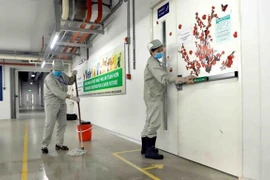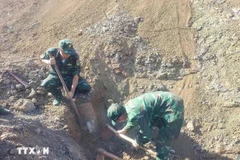This is one of the key goals of the National Programme onOccupational Safety and Health for 2021-2025.
The national programme on occupational safety and health for2021-2025 has been implemented nationwide for all occupations, prioritisingjobs with a high risk of work accidents in small and medium enterprises, cooperativesand craft villages.
The programme aims to improve working conditions, preventoccupational accidents and occupational diseases, ensure worker safety, andcontribute to sustainable development.
Vietnam will also focus on increasing the number of workersreceiving occupational disease examinations by 5 percent and increasing theestablishments with monitored working environments by 5 percent.
The programme also targets advanced training to be receivedby more than 90 percent of people in charge of managing, directing andorganising work hygiene and safety at district levels and on the managementboards of economic zones, industrial parks, export processing zones andhigh-tech zones.
Over 80 percent of employees working in occupations withstrict occupational safety requirements must be well-trained.
In addition, more than 80 percent of craft villages and cooperativeswith a high risk of occupational accidents and diseases must have access toinformation on job safety.
The programme also targets that more than 80 percent ofpeople suffering from occupational accidents and diseases are entitled tocompensation and benefits.
All fatal occupational accident cases must be reported,investigated, and handled according to the law.
The programme will draft key tasks, including perfecting thesystem of policies and laws; improving the capacity of supervision andprovision of public services on occupational safety and health; reviewing andproposing amendments to the Law on occupational safety and hygiene and relatednational technical regulations.
Other tasks such as criteria for diagnosis and assessment ofoccupational diseases and guidelines for treating occupational diseases; thelist of occupational diseases; and methods to identify hazardous occupationsmust be developed.
Equipment, facilities and human resources for the supervisionof occupational safety; quality management of products and goods; anddiagnosis, assessment, and treatment for people suffering from occupationalaccidents and diseases should be invested in and upgraded.
The programme will continue to renew educational content anddiversify information channels to raise public awareness.
Authorities must enhance research and application of scienceand technology in work safety, support safe technical solutions to combat dangerousfactors in high-risk industries such as mineral mining and processingmetallurgy, chemicals and construction.
International cooperation to mobilise support resources forworkplace safety is also needed as the country commits to International LabourOrganisation standards.
The Government requires the Ministry of Labour, Invalids andSocial Affairs to coordinate with other agencies to review, amend andsupplement the contents of policies and laws related to occupation safety;apply information technology to management, build a national database onoccupational safety; and deploy an appropriate management system for 150enterprises with high risk of occupational hazards.
Some 6,504 occupational accidents were reported nationwidein 2021. A total of 749 were fatal accidents, killing 786 people.
Ho Chi Minh City, Hanoi, Hai Duong, Thanh Hoa, Binh Duong, DongNai, Quang Ninh, Thai Nguyen were the localities with the highest number ofdeaths from occupational accidents in 2021./.





























